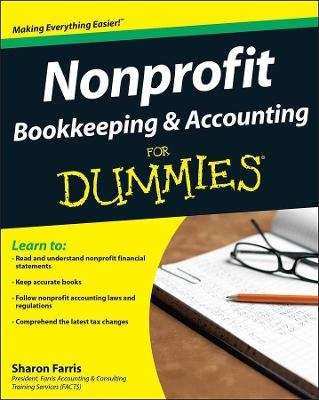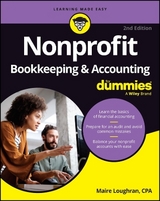
Nonprofit Bookkeeping and Accounting For Dummies
For Dummies (Verlag)
978-0-470-43236-5 (ISBN)
- Titel erscheint in neuer Auflage
- Artikel merken
Your hands-on guide to keeping great records and keeping your nonprofit running smoothly
Need to get your nonprofit books in order? This practical guide has everything you need to know to operate your nonprofit according to generally accepted accounting principles (GAAP) — from documenting transactions and budgeting to filing taxes, preparing financial statements, and much more. You’ll see how to stay organized, keep records, and be prepared for an audit.
Begin with the basics — understand common financial terms, choose your accounting methods, and work with financial statements
Balance your nonprofit books — set up a chart of accounts, record transactions, plan your budget, and balance your cash flow
Get the 4-1-1 on federal grants — find grants and apply for them, track and account for federal dollars, and prepare for a grant audit
Stay in good standing with Uncle Sam — set up payroll accounts for employees, calculate taxes and deductions, and complete tax forms
Close out your books — prepare the necessary financial statements, know which accounts to close, and prepare for the next accounting cycle
Know what to do if you get audited — form an internal audit committee, follow IRS rules of engagement, and keep an immaculate paper trail
Open the book and find:
The difference between bookkeeping and accounting
How to maintain a manual or computer record-keeping system
Ten vital things to know when keeping the books
Do’s and don’ts of managing federal grant money
How to prepare for an audit of your financial statements
IRS Form 990 good practices
The most common errors found during nonprofit audits
How to figure out employee payroll deductions and taxes
Sharon Farris has been involved in the grants industry for more than ten years. She is the president of Farris Accounting & Consulting Training Services (FACT$) as well as the former president of the American Association of Grant Professionals (AAGP) Montgomery.
Introduction 1
About This Book 1
Conventions Used in This Book 2
What You’re Not to Read 2
Foolish Assumptions 3
How This Book Is Organized 3
Part I: Accounting and Bookkeeping Nonprofit Style 3
Part II: Balancing Your Nonprofit Books 4
Part III: Accounting for Nonprofit Situations 4
Part IV: Wrapping Up the Books 4
Part V: The Part of Tens 4
Icons Used in This Book 5
Where to Go from Here 5
Part I: Accounting and Bookkeeping Nonprofit Style 7
Chapter 1: The Nuts and Bolts of Nonprofit Bookkeeping and Accounting 9
Getting Started with Your Nonprofit’s Books 10
Identifying the difference between bookkeeping and accounting 10
Picking your accounting method 11
Understanding the basic terms 12
Adhering to GAAP 15
Keeping a paper trail 16
Auditing 101: It’s a GAAS! 16
Making Sure Your Books Are Balanced 17
Establishing a chart of accounts 17
Tracking transactions 17
Developing a budget 18
Staying within the lines: Compliance 18
You’re in the Money: The Lowdown on Federal Grants 19
Gleaning some grant basics 19
Following the rules 20
Going through a grant audit 20
Paying Uncle Sam: Employee Payroll Taxes 21
Getting a Grasp on Financial Statements 21
Figuring Out Where Your Nonprofit Is: Five Important Questions 23
Chapter 2: Starting with Basic Bookkeeping and Accounting 25
Understanding Bookkeeping and Accounting 25
What’s the difference between bookkeeping and accounting? 26
Defining some common financial terms 27
Finding the Right People to Manage the Books and Monitor the Finances 29
Considering a bookkeeper or an accountant 30
Doing it yourself 31
Opting for a fiscal sponsor or agent 31
Outsourcing the job 32
Hiring an independent auditor 33
Choosing Your Accounting Method 33
Keeping track of the cash 34
Accrual basis of accounting 34
Running Numbers on Your Assets 35
Evaluating assets by original cost or fair market value 35
Grasping depreciation methods 36
Keeping an Eye on Your Assets 39
Protecting your nonprofit’s physical assets 40
Setting internal controls 40
Chapter 3: Introducing Financial Statements 43
The Lowdown on Financial Statements: Why They’re Important 43
Seeing the benefits of tracking the money 45
Who uses these statements 45
Using Financial Statements to Your Advantage 47
Assist with grant proposals 47
Allow you to track donations 48
Track nonprofit activities 48
Indicate lawsuits: Contingent liabilities 49
Identifying the Financial Statements 49
Reading the statement of activities 49
Working with the statement of financial position 52
Developing the cash flow statement 52
Grasping the statement of functional expense 55
Documenting the notes to the financial statements 55
Chapter 4: Keeping Good Records: Using a Manual System or Computer System 59
Going the Manual or Computer Route? 59
Choosing a Manual System 61
Knowing the pros and cons 61
Eyeing the parts of a manual system 62
Trying Excel: The Easy Computer Route 63
Breaking down the spreadsheet 64
Converting your manual system into a spreadsheet 65
Naming Other Available Software66
QuickBooks67
Microsoft Offi ce Accounting 67
Peachtree Accounting 68
Ensuring Your System Is Secure 69
Firewalls and virus scanners 69
User privileges and fi le sharing 70
Miscellaneous security programs 71
Backing Up Your System 71
Part II: Balancing Your Nonprofit Books 73
Chapter 5: Setting up the Chart of Accounts for Nonprofits 75
Identifying and Naming Your Nonprofit’s Main Types of Accounts 75
Accounting for assets 77
Labeling liabilities 78
Net assets: What you’re worth 79
Revenue: What you earn 80
Nonprofit expense: What you spend 82
Net income/increase – decrease in net assets 85
Coding the Charges: Assigning Numbers to the Accounts 85
Chapter 6: Recording Transactions and Journal Entries 87
Choosing Your Basis of Accounting 87
Going through the Accounting Process 88
Eyeing the specifics of the process 89
Looking at the two sides of an account 90
Recording Journal Entries 91
Step one: Write the transaction date 92
Step two: Write the account names 93
Step three: Write the amount of each debit and credit 93
Step four: Write an explanation or reason for transaction 94
Posting to the General Ledger 94
Reaching the Trial Balance 97
Preparing the trial balance: The how-to 97
Understanding which accounts require adjustments 98
Finding errors 99
Correcting errors 101
Chapter 7: Balancing the Checkbook: Donations and Expenses 103
Getting the Lowdown on Your Checkbook Register 104
Adding and Tracking Nonprofit Donations 105
Logging donations in your register 106
Raking in the cash, checks, and other donations 107
Handling and recording the donations 110
Subtracting Your Expenses 111
Making the necessary deductions in your checkbook Register 111
Identifying common expenses 112
Relying on direct or automatic bank drafts 115
Tie It Together: Balancing the Checkbook 116
Using the bank statement 116
Entering the information into QuickBooks 118
Smoothing Out and Avoiding Errors 118
Finding and addressing errors 118
Considering outstanding checks 119
Chapter 8: Balancing Cash Flow: Creating an Operating Budget 121
Eyeing the Importance of Having a Budget in the Nonprofit World 121
Getting Off to a Good Start: Preparing to Create an Operating Budget 123
Setting clear guidelines 124
Identifying your nonprofit’s objectives 125
Eyeing goals 126
Staying organized 128
Coming Up with an Operating Budget 130
Walking through the steps to the budget: The how-to 131
Getting your budget approved 134
Reviewing Budget Performance 134
Establishing a budget task group 135
Making adjustments 135
Chapter 9: Staying in Nonprofi t Compliance 137
Understanding Why Being Compliant Is Important for Your Nonprofit 138
Staying in Compliance: The How-To 138
Register with the proper state authority 138
Account for nonprofit activities 139
Hire professional help 139
Abide by IRS statutes 140
Following Accounting Standards 140
The fascinating FASB 141
The world according to GAAP 143
Sorting out the Sarbanes-Oxley Act (SOX) 146
Avoiding Activities that Can Call Your Compliance into Question 149
Conflicts of interest 149
Lobbying or supporting candidates 149
Unrelated business income 150
Part III: Accounting for Nonprofit Situations 151
Chapter 10: Introducing Federal Grants 153
Grasping Why Federal Grant Money Is Important to Nonprofits 154
The 4-1-1 on Grants: Just the Basics 155
Defining a federal grant155
Finding and applying for federal grants for your non-profit 156
Documenting where the money goes 157
Managing Federal Grant Money: The Do’s and Don’ts 159
2 CFR Part 215 for administrative requirements160
OMB Circular A-122 for cost principles 160
OMB Circular A-133 for government audit requirements 161
Working Through the Details of Your Grant Agreement 162
Summarizing the grant budget 163
Knowing the due dates for financial status reports 164
Indicating special conditions 164
Keeping the award/project period in mind 165
Treatment of program income 165
Figuring your indirect cost rate 165
Federal and nonprofit shares 165
Chapter 11: Tracking and Accounting for Federal Dollars 167
Understanding Your Obligation 168
Managing Grant Funds 169
Maintaining a separate budget for your grant dollars 169
Making changes to your grant 170
Handling the responsibility of subgrantees 171
Drawing Down Federal Dollars 173
Transferring grant money 174
Tracking the electronic transfer 175
Knowing when to request a drawdown 176
Reporting Requirements 176
Financial Standard Form 269 177
Progress reports 182
Closing Out a Grant 185
Chapter 12: Getting Ready for the Grant Audit 187
Understanding the Purpose of the Grant Audit 188
Who Should Undergo an Audit? 189
When You’re Notified: Comprehending the Nitty Gritty of the Audit 190
Identifying the Types of Grant Audits 190
The relatively painless desk audit 191
Knock, knock: Knowing what to expect during a monitoring site visit191
Preparing for the program officer’s perusal of your procedures 192
Inspector general audit: When the situation is really serious 194
Knowing What the Auditor Looks For 195
Preparing the books for audit review 196
Proving your agency’s existence with organizational records and documents 197
Tracking all grant expenses 198
Auditing Cash Management 198
Minimizing cash on hand 199
Segregating duties through internal controls 199
Receiving the Report of Audit Findings 201
Classifying the audit finding 202
Following the corrective action plan 202
Chapter 13: Accounting for Payroll and Payroll Taxes 205
Setting Up Payroll Accounts for Nonprofi t Employees 206
Deducting the Right Amount of Taxes 207
Salaries and wages 208
Overtime and cash advances 209
Calculating Specifi c FICA Payroll Taxes and Deductions 210
Paying Quarterly Payroll Taxes with Form 941 and Form 8109212
Completing Form 941 213
Filing Form 941 215
Completing Form 8109 (Making tax deposits) 216
Completing End-of-Year Forms 219
Filling out the W-2 219
Filling out the W-3 220
Where to send the W-2s and W-3s 222
Accounting for Contract Employees: Form 1099-MISC 222
Chapter 14: Doing the Accounting for Tax Form 990 225
Choosing the Right Form: Which One Do You Need? 226
Knowing What Happens If You Don’t File Form 990 227
Understanding the Minimal Requirements: Form 990-N (e-Postcard) 228
Filling Out Form 990-EZ 229
Filling Out Form 990 231
Walking through Form 990 231
Submitting Form 990 233
Completing Form 990-T (Reporting Unrelated Business Income) 234
Handling IRS Form 990 Extensions and Mistakes 236
Requesting an extension 236
Correcting Form 990 mistakes 236
Keeping in Line with IRS Regulations 238
Reporting nonprofit unrelated business income 238
Reporting nonprofit contributions239
Part IV: Wrapping Up the Books 241
Chapter 15: Analyzing the Statement of Activities 243
Understanding the True Meaning of the Statement of Activities 244
Revenues 246
Expenses 247
Gains and losses 247
What this statement doesn’t show 248
Evaluating the Data 248
Analyzing revenues and expenses 249
Determining change in net assets 250
Using the statement to make comparisons 251
Chapter 16: Reporting Financial Condition on a Statement of Financial Position 253
Grasping What the Statement Says about Your Nonprofit 253
Creating and Reading a Statement of Financial Position: The How-To 255
Understanding the statement’s structure 255
Classifying assets 258
Classifying liabilities and net assets 260
Evaluating the Numbers 264
Calculating working capital 265
Calculating a debt-to-equity ratio 265
Chapter 17: Eyeing the Cash Flow Statement 267
Seeing What the Cash Flow Statement Can Tell You about Your Nonprofit 267
Using the statement to see the big picture 268
Making decisions based on the statement 269
Understanding How to Create and Use a Cash Flow Statement 269
Getting the statement started 270
Identifying the parts of the statement 271
Doing the math 272
Analyzing Cash Flow Indicators 274
Calculating the operating cash flow ratio275
Determining free cash flow275
Chapter 18: Organizing the Statement of Functional Expense 277
Classifying Functional Expense 277
Keeping track of time 278
Allocating expenses 281
Using the Statement of Functional Expense to Calculate Ratios 284
Program spending ratio 285
Fundraising efficiency ratio 285
Chapter 19: Closing the Nonprofi t Books 287
Understanding the Need to Close Your Nonprofit’s Books 288
Adjusting, Closing and Reversing Entries289
Adjusting entries: Year-end 290
Closing entries: A 1-2-3 step 293
Reversing entries to close temporary accounts 295
Completing the Notes to the Financial Statements296
Explaining changes in accounting methods 297
Noting all lawsuits 299
Including all contingent liabilities299
Noting conditions on assets and liabilities 300
Putting Last Year Behind You and Looking Forward 300
Chapter 20: Preparing for an Accounting Audit 301
Understanding the Audit Purpose and Need 301
Considering the nonprofit constituency 302
Knowing who’s involved in the process 303
Searching for Accountability: Leaving a Paper Trail 305
Walking through the Audit Process 306
Phase I: Planning and design 306
Phase II: Calculating audit risk 306
Phase III: Analysis 307
Phase IV: Gathering final evidence and issuing the report 307
After the Audit Is Finished: Receiving the Auditor’s Report 308
Eyeing the importance of the opinion 308
Identifying the types of auditor opinions you can receive 309
If You Get Audited by the IRS 311
Part V: The Part of Tens 313
Chapter 21: Ten Important Things to Know When Keeping Nonprofit Books 315
Watch Cash Contributions315
Keep a Donors List316
Balance Your Nonprofit Checkbook 316
Leave a Paper Trail 316
Protect Your Nonprofit from Employee Theft 317
Consider Your Constituency 318
Stay in Compliance 318
Track the Truth in the Books 318
Keep Charities and Politics Separate 319
Get Free Support 319
Chapter 22: Ten Tips to Keep Your Nonprofit Viable 321
Keeping Your Books Balanced 321
File Paperwork with the IRS 322
Pay Bills on Time 323
Explore New Fundraising Ideas 323
Watch Your Nonprofit’s Bottom Line 323
Analyze, Plan, and Project Future Funding Streams 324
Get Grant-Writing Training 324
Get an Independent Audit 325
Get Acquainted with Elected Officials 325
Attend Networking Activities 326
Index 327
| Sprache | englisch |
|---|---|
| Maße | 188 x 234 mm |
| Gewicht | 476 g |
| Themenwelt | Wirtschaft ► Betriebswirtschaft / Management ► Planung / Organisation |
| Wirtschaft ► Betriebswirtschaft / Management ► Rechnungswesen / Bilanzen | |
| ISBN-10 | 0-470-43236-5 / 0470432365 |
| ISBN-13 | 978-0-470-43236-5 / 9780470432365 |
| Zustand | Neuware |
| Informationen gemäß Produktsicherheitsverordnung (GPSR) | |
| Haben Sie eine Frage zum Produkt? |
aus dem Bereich



